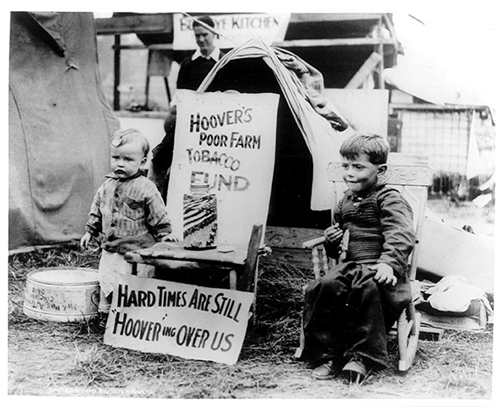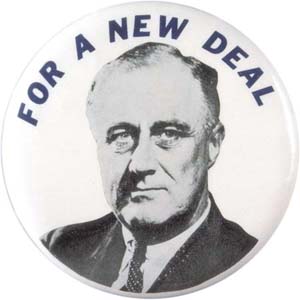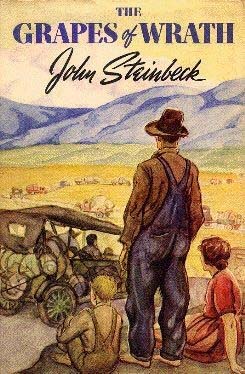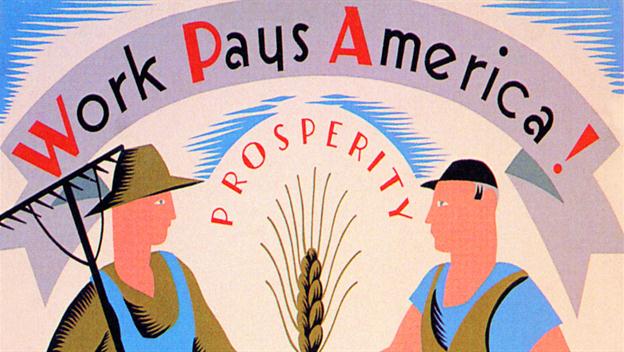In the 1920s, America was a wild and rich country. The decade was known as "the Roaring Twenties".
This was the year of prohibition, when it was illegal to make or sell alcohol. But Americans drank "bootleg" liquor sold by famous gangsters like Al Capone.Thousands of people became rich almost overnight, many by playing the Stock Market.

But suddenly, without warning, the New York Stock Market plunged on "Black Thursday", October 24th 1929. Millionaires were reduced to poverty, banks, businesses and factories closed, and vast numbers of Americans lost their jobs. This began "the Great Depression". Indeed the Great Depression began by the complete collapse of the stock market. On that day about 13 million shares of stock were sold.
The damage was extended on Tuesday, October 29th when more than 16 million shares were sold making the day forever known as Black Tuesday. The value of most shares fell sharply, leaving financial ruin and panic in its wake. There has never been a collapse in the market that has had such a devastating and long-term effect on the economy. Businesses closed and banks failed by the hundreds due to the collapse, putting millions out of work. Wages for those still fortunate enough to have work fell sharply. The value of money decreased as the demand for goods declined. In Franklin Roosevelt and the New Deal by William E. Leuchtenburg, the economic plight of the Depression is seen. "In the three years of Herbert Hoover's Presidency, the bottom had dropped out of the stock market and industrial production had been cut more than half.
By 1932, the unemployed numbered upward of thirteen million. Many lived in the primitive conditions of a preindustrial society stricken by famine." Agriculture had been in serious trouble for years. The arrival of the depression nearly eliminated it altogether, and the drought that created the 1930s Great Plains Dust Bowl greatened the damage. The government itself was pressed for income at all levels as tax revenues fell; and the government during this period was more limited in its ability to respond to economic crises than it is today. The international structure of world trade also collapsed, and each nation sought to protect its own industrial base by imposing high tariffs on imported goods. This only made matters worse.
At the time the US industrial output had been cut in half. One fourth of the labor force (about 15 million people) was out of work, and there was no such thing as unemployment insurance. Hourly wages had dropped by about 50 percent. Hundreds of banks had failed. Prices for agricultural products dropped to their lowest level since the Civil War. There were more than 90,000 businesses that failed completely. Former millionaires stood on street corners trying to sell apples at 5 cents a piece.
Anyone who had even a little money was extremely lucky. A new home could be bought for less than $3,000. A man's suit cost about $10, a shirt less than 50 cents, and a pair of shoes about $4. Milk was 10 cents a quart, a pound of steak only 29 cents, and a loaf of bread a nickel. For a dime one could go to the movies, buy a nickel bag of popcorn, and even win prizes given away by the theater. Not many lucky enough to be working had much change to spend after paying rent and buying food. To turn to the government, at least during the Hoover years, was useless. There was no federally financed "safety net" of welfare programs to keep the working class from falling into poverty.
THE MOVE WEST
Out of work and with no money, many Americans moved West, searching for opportunities to earn a living. They camped in pitiful shantytowns or large settlements called "Hoovervilles", ironically named after the President at the time, Herbert Hoover,vwho presided over the disaster. People slept under "Hoover blankets" (old newspapers) in the out-of-doors. People waited in bread lines in every city, hoping for something to eat In 1931 alone more than 20,000 Americans committed suicide.
![The Great Depression. Unemployed men queued outside a soup kitchen opened in Chicago by Al Capone. The storefront sign reads 'Free Soup, Coffee and Doughnuts for the Unemployed.' Chicago, 1930s (Newscom TagID: evhistorypix027753.jpg) [Photo via Newscom]](https://williambertrand.fr/wp-content/uploads/2017/01/Bread-Line.jpg)
Unemployed men queued outside a soup kitchen opened in Chicago by Al Capone. The storefront sign reads 'Free Soup, Coffee and Doughnuts for the Unemployed.'

ROOSEVELT'S "NEW DEAL"
In 1932, Franklin D. Roosevelt, a Democrat, was elected President. He began a program of government assistance to people in poverty, called "the New Deal". He created the Social Security system, and started large building projects to create jobs. He spoke to the American people on the radio in his famous "Fireside Chats", urging them not to lose hope. "The only thing we have to fear," he said, "is fear itself". The New Deal introduced types of social and economic reform familiar to many Europeans for more than a generation.
Moreover, the New Deal represented the culmination of a 1ong-range trend toward abandonment of "laissez-faire" capitalism, going back to the regulation of the railroads in the 1880s, and the flood of state and national reform legislation introduced in the Progressive era of Theodore Roosevelt and Woodrow Wilson. In agriculture, Congress passed the Agricultural Adjustment Act (AAA in 1933) to provide economic relief to farmers. The AAA planned to raise crop prices by paying farmers a subsidy to compensate for voluntary cutbacks in production. The funds for the payments would be generated by a tax levied on industries that processed crops.
Between 1932 and 1935, farm income increased by more than 50 percent, but only partly because of federal programs. During the same years that farmers were being encouraged to take land out of production, which would displace tenants and sharecroppers, the farm production was significantly reduced due to a severe drought that hit the Great Plains states. Violent wind and dust storms ravaged the southern Great Plains in what is known as the "Dust Bowl," throughout the 193Os, but particularly from 1935 to 1938 The damages were immense People and animals were harmed, crops were destroyed, cars and machinery were ruined. Approximately 800,000 people; often called "Okies," left Arkansas, Texas, Missouri and Oklahoma during the 1930s and 1940s. Most of these travellers headed west to California, the land of myth and promise. The migrants were not only farmers, but also professionals, retailers and others whose livelihoods were connected to the health of the farm communities. California didn't live up to their expectations, however, as conditions in the sunny state were just as bad as those in the places from which the migrants fled.
Most migrants ended up competing for seasonal jobs picking crops at extremely low wages. This historic moment is portrayed in the book The Grapes Of Wrath by John Steinbeck.
Although the AAA had been mostly successful, it was abandoned in 1936; when the tax on food processors was ruled unconstitutional. Six weeks later Congress passed a more effective farm-relief act, which authorized the government to make payments to farmers who reduced plantings of soil-depleting crops.
By 1940 nearly 6 million farmers were receiving federal subsidies under the farm relief act. The new act likewise provided loans on surplus crops, insurance for wheat and a system of planned storage to ensure a stable food supply. The prices of agricultural commodities rose, leaving the farmer's with a sense of economic stability.
THE SECOND NEW DEAL
The increasing pressures of the Great Depression caused President Roosevelt to back a new set of economic and social measures to fight poverty, to counter unemployment with work and to provide a social safety net.

The Works Progress Administration (WPA), the principal relief agency of the second New Deal, was an attempt to provide work rather than welfare. Under the WPA, buildings, roads, airports and schools were constructed. Actors, painters, musicians and writers were employed through the Federal Theater Project, the Federal Art Project and the Federal Writers Project. In addition, the National Youth Administration gave part-time employment to students, established training programs and provided aid to unemployed youth. Although the WPA only included about three million jobless at a time, it had helped a total of 9 million people when it was abandoned in 1943.
SOCIAL SECURITY
The New Deal's cornerstone according to Roosevelt, was the Social Security Act of 1935. It "reversed historic assumptions about the nature of social responsibility, and it established the proposition that the individual has clear-cut social rights. In addition to several provisions for general welfare, the new Act created a social insurance program designed to pay retired workers age 65 or older a continuing income after retirement. Social Security created a system of insurance for the aged, unemployed and disabled based on employer and employee contributions. Social Security was funded in large part by taxes on the earnings of current workers, with a single fixed rate for ail regardless of income".
President Roosevelt stated upon signing Social Security Act:
"We can never insure one hundred percent of the population against one hundred percent of the hazards and vicissitudes of life, but we have tried to frame a law which will give some measure of protection to the average citizen and to his family against the loss of a job and against poverty-ridden old age."

When congress passed the Social Security Act, the most pressing problems were double-digit unemployment and pervasive poverty. While the Social Security Act slightly affected most of the population in 1935, it began a program that has lasted for 64 years. Although its origins were initially quite modest, Social Security today is one of the largest domestic programs administered by the U.S. government. Millions of people depend on Social Security to protect them in their old age.
While the Social Security program is very complex and deals with more than 6 million employers, tens of millions of beneficiaries, and over 100 million taxpayers, its administrative costs are very low - roughly 1% of retirement and survivor pension payments.
From its modest beginnings, Social Security has grown to become an essential aspect of modern life. One in seven Americans receives a Social Security benefit, and more than 90 percent of all workers are in jobs covered by Social Security. From 1940, when slightly more than 222,000 people received monthly Social Security benefits, until today, when over 42 million people receive such benefits; Social Security has grown steadily.
![The Great Depression. Unemployed men queued outside a soup kitchen opened in Chicago by Al Capone. The storefront sign reads 'Free Soup, Coffee and Doughnuts for the Unemployed.' Chicago, 1930s (Newscom TagID: evhistorypix027753.jpg) [Photo via Newscom]](https://williambertrand.fr/wp-content/uploads/2017/01/Bread-Line.jpg)





